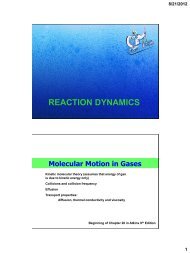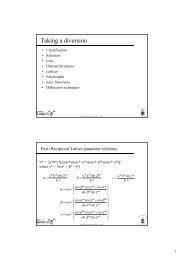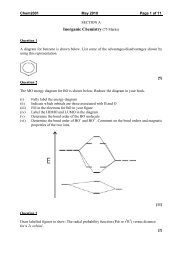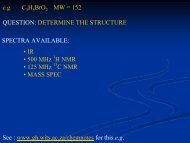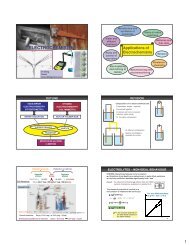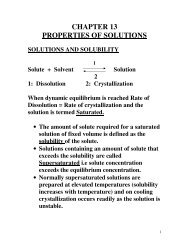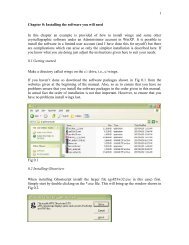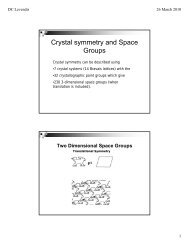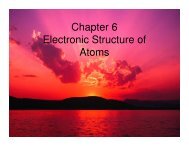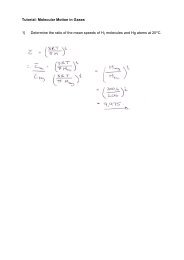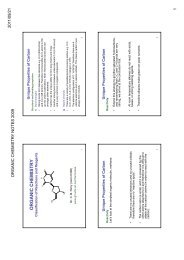ELECTROCHEMISTRY - Wits Structural Chemistry
ELECTROCHEMISTRY - Wits Structural Chemistry
ELECTROCHEMISTRY - Wits Structural Chemistry
Create successful ePaper yourself
Turn your PDF publications into a flip-book with our unique Google optimized e-Paper software.
Exchange Current Density<br />
Under zero current conditions:<br />
Dynamic Equilibrium<br />
Ox + ne - Red<br />
o RT a<br />
Eeq<br />
= E − ln<br />
nF a<br />
Re d<br />
Ox<br />
EQUILIBRIUM!<br />
Overpotential (η):<br />
the difference between the applied potential and the<br />
equilibrium potential.<br />
η = E – E eq<br />
Equilibrium potential: potential where i = 0<br />
By definition, no net chemical change occurs i = 0<br />
However, this is a dynamic equilibrium! i = ia + ic<br />
= 0<br />
Increasing rate of reduction<br />
η = E – E eq<br />
E eq<br />
Increasing rate of oxidation<br />
η = E – E eq<br />
i.e. there is still current flowing:<br />
i a = −ic<br />
= io<br />
E eq<br />
exchange current<br />
η > 0<br />
Recall: current is the variation of charge with time:<br />
current ∝ rate of electron transfer<br />
dq<br />
i =<br />
dt<br />
η < 0<br />
i o is a measure of the electron transfer activity in both cathodic and anodic directions<br />
at equilibrium.<br />
It is a very useful kinetic parameter in dynamic electrochemistry.<br />
Rate of e - transfer depends on the electrode potential which drives the<br />
transfer of e - ’s.<br />
Current is defined as:<br />
i = nFAν<br />
A = surface area of electrode<br />
ν = reaction rate<br />
Forward reaction:<br />
Reverse reaction:<br />
k k ox<br />
Ox + ne - red<br />
Red<br />
Red Ox + ne-<br />
ν<br />
red<br />
= k<br />
red<br />
C<br />
i<br />
ν c<br />
red<br />
=<br />
nFA<br />
Butler-Volmer<br />
Equation<br />
ox<br />
1 st order<br />
Current at electrode:<br />
ν = k C<br />
ox<br />
ox<br />
i<br />
ν a<br />
ox<br />
=<br />
nFA<br />
Overall rate:<br />
1<br />
ν = νox<br />
− νred<br />
= koxCred<br />
− kredCox<br />
= (ia<br />
− ic<br />
)<br />
nFA<br />
i = ia<br />
− ic<br />
= nFA(k oxCred<br />
− kredCox<br />
)<br />
red<br />
Note: c red or c ox refers to the<br />
conc’s near the electrode surface<br />
Forward reaction:<br />
Reverse reaction:<br />
k<br />
Ox + ne - red<br />
k ox<br />
Red<br />
Red Ox + ne-<br />
Current at electrode:<br />
The rate constant varies with applied potential (in an exponential way):<br />
(1−α<br />
)nF<br />
−αnF<br />
η<br />
η<br />
o<br />
o<br />
RT<br />
RT<br />
k = kred<br />
= k e<br />
ox<br />
k e<br />
k o = standard rate constant (k when potential applied is E eq )<br />
α = transfer coefficient (0 < α < 1) → symmetry factor<br />
(1− α)nF<br />
o<br />
i = nFAk C RT<br />
<br />
rede<br />
<br />
i = ia<br />
− ic<br />
= nFA(k oxCred<br />
− kredCox<br />
)<br />
η<br />
− Coxe<br />
− αnF<br />
η <br />
RT<br />
<br />
<br />
(1− α)nF<br />
− αnF<br />
η<br />
η <br />
i = i RT − RT<br />
o e e<br />
<br />
<br />
<br />
<br />
Butler-Volmer equation<br />
and<br />
o<br />
io = nFAk C<br />
Current (rate of reaction) depends on:<br />
• Electrode area, A<br />
• Concentration of reactant, C<br />
• Temperature<br />
• The kinetic parameters i o and α<br />
• Overpotential, η<br />
Current density, j:<br />
i<br />
j =<br />
A<br />
(1− α)nF<br />
− αnF<br />
η<br />
η <br />
j = j RT − RT<br />
o e e<br />
<br />
<br />
<br />
<br />
(1−α)nF<br />
− αnF<br />
η<br />
η <br />
i = i RT − RT<br />
o e e<br />
<br />
<br />
<br />
<br />
i = nFAν<br />
j is independent of electrode area<br />
Butler-Volmer equation in<br />
terms of current density<br />
For small overpotentials (η < ~10 mV):<br />
nF<br />
j = joη<br />
RT<br />
In most practical situations, only the forward or the reverse reaction is significant and<br />
a simplified equation is sufficient.<br />
Large, positive overpotential predominantly oxidation:<br />
In practise, η ≥ ~ +0.12/n V<br />
j<br />
(1−α<br />
)nF<br />
η<br />
RT<br />
= j e o<br />
(1− α)nF<br />
ln j = ln jo<br />
+ η<br />
RT<br />
Large, negative overpotential predominantly reduction:<br />
In practise, η ≤ ~ -0.12/n V<br />
j<br />
−αnF<br />
η<br />
RT<br />
= j e o<br />
αnF<br />
ln j = ln jo<br />
− η<br />
RT<br />
(1− α)nF<br />
j = j RT<br />
o e<br />
<br />
<br />
η<br />
− e<br />
Anodic current<br />
− αnF<br />
η <br />
RT<br />
<br />
<br />
Cathodic current<br />
i.e. η nF < 1<br />
RT<br />
Low field region<br />
High field region<br />
Tafel equations<br />
8



